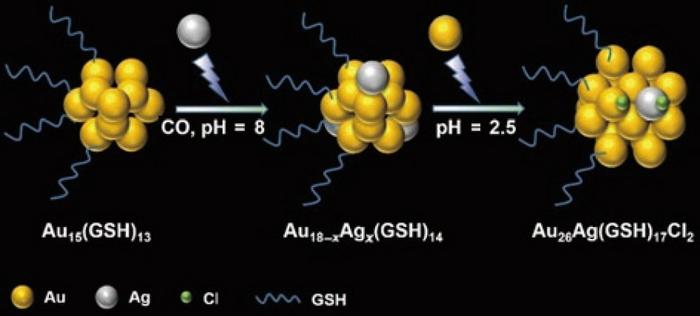In recent years, ultrasmall metal nanoclusters have unlocked advances in fields ranging from bioimaging and biosensing to biotherapy thanks to their unique molecular-like properties. In a study published in the journal Polyoxometalates on December 11, 2023, a research team from Qingdao University of Science and Technology proposed a design to synthesize atomically precise, water-soluble alloy nanoclusters.

Credit: Xun Yuan, School of Materials Science and Engineering, Qingdao University of Science and Technology
In recent years, ultrasmall metal nanoclusters have unlocked advances in fields ranging from bioimaging and biosensing to biotherapy thanks to their unique molecular-like properties. In a study published in the journal Polyoxometalates on December 11, 2023, a research team from Qingdao University of Science and Technology proposed a design to synthesize atomically precise, water-soluble alloy nanoclusters.
“The novelty of this study is in a new strategy for the synthesis of water-soluble alloy nanoclusters and a further contribution to the fundamental understanding of the alloying mechanism of metal nanoclusters,” said study author Xun Yuan from Qingdao University of Science and Technology.
“The ultimate goal is to develop such alloy nanoclusters as novel nanomedicine,” Yuan said.
Nanoclusters are made of only a few to tens of atoms, and the size of their cores is usually below 2 nanometers (nm). Since the ultra-small size of the clusters is close to the Fermi wavelength of electrons, the continuous band turns to discontinuous and becomes molecule-like with discrete energy levels. Consequently, the nanoclusters exhibit unique optical and electronic characteristics.
Recent studies have demonstrated how alloy nanoclusters — synthesized by combining two or more different metals into a monometallic nanocluster framework — can generate new geometric structures and additional functionality. Researchers can “tune” the physical and chemical properties (e.g., optical, catalytic, and magnetic) of metal nanoclusters. Moreover, alloy nanoclusters often exhibit synergistic or new properties, which go beyond those of monometallic nanoclusters.
Heightened interest in potential opportunities has spurred recent activity to develop new methods to synthesize alloy nanoclusters. But, while the correlations between size, morphology, and composition of alloy nanoclusters and their physicochemical properties have been well demonstrated, issues surrounding doping processes and the dynamic responses are not well understood, according to Yuan.
“These unresolved issues are mainly due to the technical limitations in characterizing the alloy atom distribution at the atomic level, especially in real-time tracking of the dynamic heteroatom movement in the alloy nanoparticles during the reactions,” Yuan said.
In addition, most of those methods were exploited for hydrophobic alloy nanoclusters, which may preclude synthesis for water-soluble alloy nanoclusters. Given the wide application of water-soluble alloy nanoclusters in biomedicine and environmental protection, developing novel synthetic strategies of water-soluble alloy nanoclusters at the atomic level is significantly important.
With this goal in mind, Yuan and collaborators found that seeding silver (Ag) ions could trigger the transformation from gold (Au)-based nanoclusters into alloy Au18-xAgx(GSH)14 nanocluster which can be further transformed to composition-fixed Au26Ag(GSH)17Cl2 nanoclusters by gold (Au) ions— with GSH denoting water-soluble glutathione. Moreover, the position of the single Ag atom of Au26Ag(GSH)17Cl2 nanoclusters could be identified on the surface.
“Our results could achieve the atom-level modulation of metal nanoparticles, and provide a platform for producing alloy functional nanomaterials for specific applications,” said Yuan. “Additionally, the acquired alloying mechanism may deepen the understanding on the properties-performance of alloy nanomaterials, contributing to the generation of new knowledge in the fields of nanomaterials, chemistry, and nanocluster science.”
In future studies, the researchers will use these alloy nanoclusters for biomedical applications.
The research is supported by the National Natural Science Foundation of China and the Taishan Scholar Foundation of Shandong Province.
Other contributors include Shuyu Qian, Fengyu Liu, Haiguang Zhu, Yong Liu, Ting Feng and Xinyue Dou from Qingdao University of Science and Technology.
About Polyoxometalates
Polyoxometalates is a peer-reviewed, international and interdisciplinary research journal that focuses on all aspects of polyoxometalates, featured in rapid review and fast publishing, sponsored by Tsinghua University and published by Tsinghua University Press. Submissions are solicited in all topical areas, ranging from basic aspects of the science of polyoxometalates to practical applications of such materials. Polyoxometalates offers readers an attractive mix of authoritative and comprehensive Reviews, original cutting-edge research in Communication and Full Paper formats, Comments, and Highlight.
About SciOpen
SciOpen is a professional open access resource for discovery of scientific and technical content published by the Tsinghua University Press and its publishing partners, providing the scholarly publishing community with innovative technology and market-leading capabilities. SciOpen provides end-to-end services across manuscript submission, peer review, content hosting, analytics, and identity management and expert advice to ensure each journal’s development by offering a range of options across all functions as Journal Layout, Production Services, Editorial Services, Marketing and Promotions, Online Functionality, etc. By digitalizing the publishing process, SciOpen widens the reach, deepens the impact, and accelerates the exchange of ideas.
Journal
Polyoxometalates
DOI
10.26599/POM.2023.9140049
Article Title
Metal ion-induced alloying and size transformation of water-soluble metal nanoclusters
Article Publication Date
11-Dec-2023




